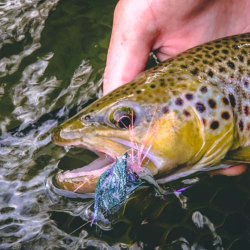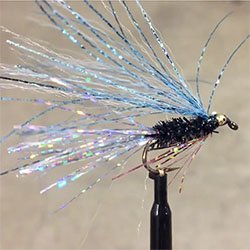Tying With Kreinik
This section includes how-to articles and inspiration for adding Kreinik fly tying materials to your tackle box.
-
How to use Micro Ice Chenille
Kreinik Micro Ice Chenille is the perfect metallic chenille for bodies on any size lure. Wrap once, twice, or as many times as desired. Combine it with Kreinik Braids, Ribbons and Flash for the most effective fly fishing lures you'll ever use. Experiment and have fun with this fiber.
Watch fly tyer Val Roberts using Kreinik Micro Ice Chenille (the pink) and Kreinik Flash (the red) to make a body on this scud-like fly. In addition to the metallic shimmer and fuzzy texture, the pink chenille has some UV properties.
Here Val uses Micro Ice Chenille to replicate a catepillar:
-
Micro Ice Chenille Ideas from Harrison Steeves
Marvelous Micro Ice Chenille: ideas for using this fuzzy metallic for fly fishing lures
by Harrison Steeves III
If you have ever tied anything using standard size ice chenille, or one of the similar products, you may have done what I have: you looked at the fly, held it up to the light, and thought, “Boy, if I could just find something in a smaller diameter, I could tie some neat little streamers instead of these monsters.” Well, here it is. Kreinik Micro Ice Chenille is about half the diameter of regular ice chenille, which has allowed me do a lot of things I used to only dream about.
I use the Micro Ice Chenille for many purposes:
- You can use it to wrap bodies on patterns such as Woolly Buggers, Sculpins, Zonkers, Muddler Minnows, and other assorted streamers.
- It also makes fantastic bodies on salmon and steelhead flies, big Zug Bugs and Prince Nymphs (I use Kreinik color 850 Mallard for these), Clouser Minnows, Deceivers, and a host of other flies.
- I have tied quite a few of the Crazy Charley patterns using Micro Ice Chenille for the body wrap, and it allows me to tie the smaller sizes (which many times seem to outfish the bigger ones) with no trouble whatsoever. As a matter of fact, one of the most well-known Christmas Island bonefish guides went ballistic over the material a few years ago at the International Fly Tackle Dealer Show in Denver.
Other than the obvious use of this material to wrap bodies on subsurface flies of all types, what else can you do with it? Actually, it has quite a few other applications you might want to try
- I have used it to wrap the bodies of both hopper and cricket patterns. While I'm not going to make any generalizations, there have certainly been days when these have outfished their regular counterparts. One of the patterns is simply a Letort Cricket tied with a body of either Black, Mallard or Peacock Micro–Ice (which Rob Cramer, former owner of the Mossy Creek Fly Shop in Virginia, introduced to the general public as the Disco Cricket). For a number of years, I have been tying a Letort Hopper, a la Ed Shenk, with a body formed from yellow Micro Ice Chenille, and I have been very pleased with the results. I suppose this should be named the Disco Hopper?
- The material is small enough in diameter to use it for the thorax on many of the nymph patterns, as was done on Steeves' Braided Bitch and some of the other nymph patterns marketed through Umpqua. You might want to give this a try on some of your favorite nymph patterns; it does away with the mess associated with dubbing and forms a wonderful fuzzy, sparkling thorax that just seems to naturally attract fish.
- I have been tempted to use the Micro Ice Chenille for the body wrap on some of the really large dry flies; something like a great big Humpy or Wulff pattern could be very interesting. What about using it for the body on some of the big stonefly patterns, or on the Madame X, Tarantula, Stimulator, or some of the damsel and dragon fly dry fly patterns? Any big pattern loaded with deer hair, foam, hackle, elk hair, caribou or some other highly floatable material is certainly a candidate for trial. Try these ideas and let me know what happens; I promise I won't tell anybody else.
Helpful Hint: Try the following if you really want to produce a wrap in which the material in any of the "Ice Chenilles" is absolutely and irrevocably locked in place... Instead of tying in a strand of Micro Ice Chenille and wrapping it in the usual manner, tie it in as a loop. In other words, tie in both ends to form a loop in the same way that you would form a dubbing loop using thread. Then, using a dubbing spinner hooked in the closed end of the loop, twist the two strands together before wrapping the material forward. Using this procedure assures you that all of the little glittery pieces in the strand will never fall out. Also, it does not increase the diameter of the material and it gives a fuller and more luxuriant wrap.

-
Kreinik Flash ideas from an expert
Kreinik Flash is your secret ingredient for success every time you fish
by Harrison Steeves III
Tired of fighting the static electricity, or wish that other brands of flash were a little bit limper to get more action out of it? Well then, shift to Kreinik Flash.
Does this sound like some sort of sales hype on a used car lot? Maybe it does, but once you try this material I don't believe you'll think so. I did a “double take” when I first saw this material hanging on the walls of the conference room at Kreinik. It turned out to be the material in its raw form before it was woven into the braids and ribbons. My reaction was, “Give it to me! I'll take every color you have.” The material is called Kreinik Flash. Since that day, I have stopped using other brands of flash entirely and use them only for some very special (and I do mean special) applications. I have enough problems in my life and don't need to waste time fighting with fly tying materials.
What I particularly like about the put-ups of Kreinik Flash is the nifty way they come packaged: in a clear plastic tube, with a lock tie in the middle. The end of the lock tie is passed through the tube and the material is pulled into the tube until just the right amount sticks out of the end. You can cut off the right amount and keep the remainder in the package without making a mess. Plus, you can store dozens of these tubes in a very tight space. My travelling fly tying kit has a complete selection of colors neatly tucked away in compartments.

Even though I used other brands in the past, the static electricity associated with some of these products drove me nuts. The Kreinik material, for whatever reason, does not exhibit this quality. If you don’t believe me, try rubbing the material all over your hands and you will see that it won't make any difference.
 Kreinik Flash has some other nice qualities:
Kreinik Flash has some other nice qualities:- There is a very small supportive thread fiber associated with this material that makes it very tough, tougher than most other brands of material, while being flexible. These colors are referred to as "supported Flash" colors.
- You can also get "unsupported Flash" without that supportive fiber, giving you a totally different movement in the water.
- It has sparkle, and it comes in just about any color you could ask for.
- It is also priced competitively, and for those of you who tie commercially it is available in bulk.
I can't tell you everything I do with this versatile material because there are so many options. As I stated previously, I use it almost exclusively in patterns calling for other products of this type, but I have also taken its use a bit further. For example, I tie saltwater flies using only the Kreinik Braids, Ribbons, and Flash. Also, since it is made of the same material as the braids and ribbons, the colors for the flash can be matched exactly to the braids and ribbons. I don't use any hair, feathers, or other natural materials. Heresy? I don't think so. If you are going to fish for toothy varmints, why not tie flies they can't tear up so easily? It's as simple as that.

I have also tied salmon and steelhead flies using only the Kreinik materials. Tags, butts, and bodies are tied using the braids and ribbons, and the wings and beards are tied using combinations of colors available in the Kreinik Flash. I once tied up a series for Jim Bashline who used them with great success, even to the point of having a guide come over and beg him to show him the pattern he was using. Jim and I talked extensively about tying salmon and steelhead flies using only the Kreinik materials.

I also use Kreinik Flash when tying midge larvae. A single strand wrapped around the shank of a tiny hook produces one of the finest midge larva you can imagine. Even if you tie a lot of them, there are probably enough fibers in a single hank of the material to last you for years. On dubbed body midge larvae, try ribbing the body with a strand of the material. It works like a charm and adds just enough color, sparkle, and flash to increase your odds considerably.

What do the letters mean? Colors ending in a "V" such as 001V have a matte, less reflective finish. Colors ending in a "HL" such as 001HL are hi-lustre and are very shiny. Colors ending in a "L" such as 001L are holographic. Colors ending in a "F" will glow-in-the-dark when exposed to light.

-
What does "Supported Flash" mean?
The white material you see in this lure is a supporting thread, which comes in some Kreinik metallic Flash. It's thinner than hair but adds just a touch of body. Also helps to reduce static. Many Kreinik Flash colors come in supported or unsupported versions to give you more options.







